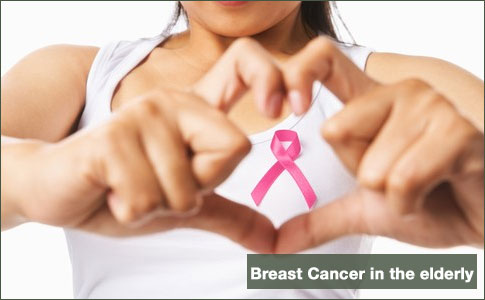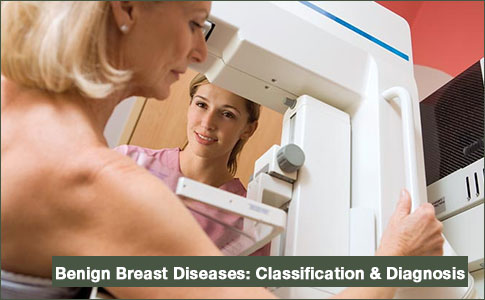Health Centers > Cancer Health Center > Breast Cancer > Breast Cancer overview
Breast Cancer Overview
Breast cancer is a malignant proliferation of epithelial cells lining the ducts or lobules of the breast. In the year 2004, about 216,000 cases of invasive breast cancer and 40,000 deaths occurred in the United States. Epithelial malignancies of the breast are the most common cause of cancer in women (excluding skin cancer), accounting for about one-third of all cancer in women. As a result of improved treatment and earlier detection, mortality from breast cancer has begun to decrease substantially in the United States. This chapter will not consider rare malignancies of the breast, such as sarcomas and lymphomas, but will focus on the epithelial cancers. Human breast cancer is a clonal disease; a single transformed cell - the product of a series of somatic (acquired) or germline mutations - is eventually able to express full malignant potential. Thus, breast cancer may exist for a long period as either a noninvasive disease or an invasive but nonmetastatic disease. These facts have very significant clinical ramifications.
Genetic Considerations
Not more than 10% of human breast cancers can be linked directly to germline mutations. Several genes have been implicated in familial cases. The Li-Fraumeni syndrome is characterized by inherited mutations in the p53 tumor-suppressor gene, which lead to an increased incidence of breast cancer, osteogenic sarcomas, and other malignancies. Inherited mutations in PTEN have also been reported.
Another tumor-suppressor gene, BRCA-1, has been identified at the chromosomal locus 17q21; this gene encodes a zinc finger protein, and the product therefore may function as a transcriptional factor. The gene appears to be involved in gene repair. Women who inherit a mutated allele of this gene from either parent have at least a 60 to 80% lifetime chance of developing breast cancer and about a 33% chance of developing ovarian cancer. The risk is higher among women born after 1940, presumably due to promotional effects of hormonal factors. Men who carry a mutant allele of the gene have an increased incidence of prostate cancer and breast cancer. A fourth gene, termed BRCA-2, which has been localized to chromosome 13q12, is also associated with an increased incidence of breast cancer in men and women.
BRCA-1 and BRCA-2 can now be sequenced readily and germline mutations detected; patients with these mutations can be counseled appropriately. All women with strong family histories for breast cancer should be referred to genetic screening programs whenever possible, particularly women of Ashkenazi Jewish descent who have a high likelihood of a specific BRCA-1 mutation (deletion of adenine and guanine at position 185).
Even more important than the role these genes play in inherited forms of breast cancer may be their role in sporadic breast cancer. The p53 mutation is present in approximately 40% of human breast cancers as an acquired defect. Acquired mutations in PTEN occur in about 10% of the cases. BRCA-1 mutation in primary breast cancer has not been reported. However, decreased expression of BRCA-1 mRNA (possibly via gene methylation) and abnormal cellular location of the BRCA-1 protein have been found in some breast cancers. Loss of heterozygosity of BRCA-1 and BRCA-2 suggests that tumor-suppressor activity may be inactivated in sporadic cases of human breast cancer. Finally, increased expression of a dominant oncogene plays a role in about a quarter of human breast cancer cases. The product of this gene, a member of the epidermal growth factor receptor superfamily, is called erbB2 (HER-2, neu) and is overexpressed in these breast cancers due to gene amplification; this overexpression can contribute to transformation of human breast epithelium.
Breast Cancer



Hereditary Breast Cancers
A family history of breast cancer has been consistently recognized as one of the most important risk factors for the disease ...

Breast Cancer Overview
Breast cancer is a malignant proliferation of epithelial cells lining the ducts or lobules of the breast ...

Other Causes of Hereditary Breast Cancer
It is important to bear in mind that not all families with a pedigree suggestive of hereditary breast cancer are linked to BRCA1 or BRCA2...

Prevention Strategies for Women with BRCA1 or BRCA2 Mutations
Given the uncertain utility of screening programs (secondary prevention) in this high-risk ...

Nipple Discharge
Nipple discharge is a common breast symptom and one that can be particularly alarming when first discovere ...

Breast Cancer Risk Factors
Identification of risk factors is important in explaining the variation in breast cancer incidence across different populations ...
Daily Breast Cancer News
- Bening Breast Disorders
- Carcinoma of the Female Breast
- Carcinoma of the Male Breast


